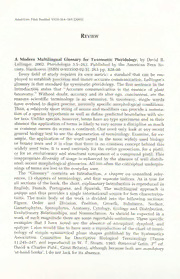
A Modern Multilingual Glossary for Taxonomic Pteridology PDF
Preview A Modern Multilingual Glossary for Taxonomic Pteridology
American Fern Journal 93(3]:164-165 (2003) Review A Modern Taxonomic Multilingual Glossary by David for Pteridology, B. Lellinger. 2002. Pteridologia 3:5-263. Published by the American Fern So- Hardcover [ISBN 0-933500-02-5]. 263 ciety. $28.00. pp. own Every field of study requires metric: a standard that can be em- its ployed and to establish precision insure accurate communication. Lellinger's glossary is that standard for systematic pteridology. The sentence the in first Introduction "Accurate communication states that the essence of plant is taxonomy." Without doubt, accuracy and its alter ego, conciseness, are the reasons scientific terminology so extensive. In taxonomy, words is single have evolved to depict precise, narrowly morphological specific conditions. Thus, a relatively short string of nouns and modifiers can provide summa- a tion of a species hypothesis as well as define predicted boundaries with sis- ter taxa. Unlike species, however, terms have no type specimens and in their absence the application of terms vary much is likely to across a discipline as common names do One as across a continent. need only look any recent at general biology text to see the degeneration of terminology. Examine, for ex- ample, word the application of the carpel in the more widely used biology or botany and no common texts clear that there concept behind it is is this widely used used term. variously the gynoecium, It is for entire for a pistil, or an evolutionary and component compound for structural of a This pistil. inappropriate diversity of usage enhanced by the absence of well is distrib- uted, recent morphological glossaries. All too often the conceptual underpin- nings of terms are lost to the everyday user. The "Glossary" contains an Introduction, a chapter on consulted refer- ences, 13 chapters of terminology, and four separate indices. As true for is all sections of the book, the short, explanatory Introduction reproduced in is English, French, Portuguese, and The Spanish. multilingual approach is unique and thus provides a single international source for fern characteriza- The main body work tions. of the divided into the following is sections: Order and Figure, Division, Position, Growth, Substance, Surface, Gametophytes, Sporophytes, Anatomy, Cytology, Ecology and Distribution, Evolutionary Relationships, and Nomenclature. As should be expected in a work of such magnitude some there are regrettable omissions. Three specific examples have that noted are the absence of aneuploid, and I dysploid, would epitype. also like to have seen a reproduction I of the chart of termi- nology of simple symmetrical plane shapes published by the Systematics Association Committee for Descriptive Biological Terminology (Taxon W 11:245 David & Charles PubL, Great Britain), although because both mandatory are do 'at-hand books', not lack for absence. I its 165 In the short time that have had this glossary, have used at least once I I it or twice every week. Already becoming dog-eared from Thank- it is a bit use. — my my fully have three copies at had one in office, a second in lab, and a I our herbarium book must third in library. Lellinger's is a for all professional, — many and avocational, pteridologists. R. James Hickey, Botany Department, OH Miami University, Oxford, 45056.
